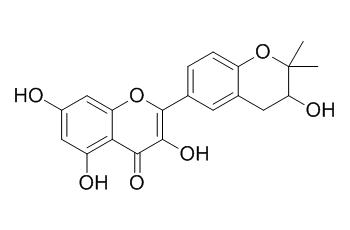Glycyrrhiza flavonol A
Reference standards.
Inquire / Order:
manager@chemfaces.com
Technical Inquiries:
service@chemfaces.com
Tel:
+86-27-84237783
Fax:
+86-27-84254680
Address:
1 Building, No. 83, CheCheng Rd., Wuhan Economic and Technological Development Zone, Wuhan, Hubei 430056, PRC
Providing storage is as stated on the product vial and the vial is kept tightly sealed, the product can be stored for up to
24 months(2-8C).
Wherever possible, you should prepare and use solutions on the same day. However, if you need to make up stock solutions in advance, we recommend that you store the solution as aliquots in tightly sealed vials at -20C. Generally, these will be useable for up to two weeks. Before use, and prior to opening the vial we recommend that you allow your product to equilibrate to room temperature for at least 1 hour.
Need more advice on solubility, usage and handling? Please email to: service@chemfaces.com
The packaging of the product may have turned upside down during transportation, resulting in the natural compounds adhering to the neck or cap of the vial. take the vial out of its packaging and gently shake to let the compounds fall to the bottom of the vial. for liquid products, centrifuge at 200-500 RPM to gather the liquid at the bottom of the vial. try to avoid loss or contamination during handling.
Korea Food Research Institute2024, 4798082
Front Immunol.2020, 11:598556.
Phytother Res.2019, 33(5):1490-1500
Oncotarget.2015, 6(31):30831-49
J of l. Chroma.&Related Tech2020, 43(11-12):414-423.
Nature Ecology & Evolution2020, doi: 10.1038
Synthetic and Systems Biotechnology2023, j.synbio.
Industrial Crops and Products2024, 129:119014
Food and Agriculture Org. Of the UN2019, 151-160
Exp Neurobiol.2018, 27(3):200-209
Related and Featured Products
Chemical and Pharmaceutical Bulletin,1997,45(9): 1485-1492.
Phenolic Constituents of Liquorice. VII. A New Chalcone with a Potent Radical Scavenging Activity and Accompanying Phenolics from Liquorice[Reference:
WebLink]
METHODS AND RESULTS:
Twenty-three phenolics including six new compounds were isolated from a commercial liquorice from North-eastern China. Structures 2-7 were assigned for the new compounds, designated as tetrahydroxy-methoxychalcone, isolicopyranocoumarin, Glycyrrhiza flavonol A, and glycyrrhiza-isoflavones A, B and C, respectively. Compound 2 showed the most potent scavenging effect on 1,1-diphenyl-2-picrylhydrazyl radical among the tested polyphenols isolated from liquorice.
CONCLUSIONS:
Air-oxidation of 2 in alkaline dimethylsulfoxide solution gave strong ESR signals, indicating the stability of the radical species formed from 2.



